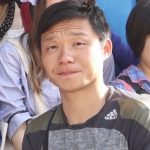Hometown in Japan: Shizuoka
Home University: Ritsumeikan University, Faculty of Science and Engineering, Physical Science
B4: Senior, Expected Graduation Date: March 2019
Host Professor: Prof. Doug Natelson, Depts. of Physics & Astronomy (Chair), Electrical & Computer Engineering, and Materials Science & NanoEngineering
Research Project Poster (PDF): “The interaction of gold nanostructure with different laser polarization in COMSOL simulation”
Why Nakatani RIES?
The Nakatani RIES Fellowship program will be a milestone for my career development because I am eager to enroll in a foreign graduate school and hope to work internationally after that. To accomplish this goal, I applied to Nakatani RIES with the desire to change my environment and to get research skills in a different situation and the improve my command of the English language. What is more, we rarely get such a wonderful chance to do research in the U.S. as an undergraduate student in Japan.
I believe that discussion with people who have different values can create completely new things, regardless of research area. I am looking forward to broadening my worldview by having a lot of interesting experiences in the U.S. That will make me bigger, I believe.
- To learn about real research flow in the U.S.
- To master English as much as possible
- To feel Great America
- To make friends through board games
- To produce “Rice Ball” in Rice university as Japanese culture
Nakatani RIES Program Experience
- My favorite experience in the U.S. … was visiting Johnson Space Center twice.
- Before I left for U.S. I wish I had… lost more weight.
- While I was in the U.S. I wish I had… read more papers and had more discussions with lab members.
Excerpts from Katsuya’s Weekly Reports
- Week 01: Arrival in the U.S.
- Week 02: Life in My Research Lab at Rice
- Week 03: Interview with U.S. Student and Researcher
- Week 04: Reflections on English Language & Life in the U.S.
- Week 05: Final Week at Rice and Research in the U.S. vs. Research in Japan
- Research Project Overview and Poster
- Week 06: Last Week in the U.S.
- Final Report
- Tips for Future Participants
Week 01: Arrival in the U.S.
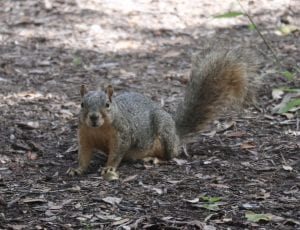 One thing I did to prepare for living/life in the U.S. before coming to Houston was to keep in mind my distinctive purposes during this program. According to the helpful seminar “Transferable Skills Development for Ph.D. Careers” given by Prof. Yoshichika Iida during the Pre-Departure in Kyoto, he told us not only what a Ph.D. is but also how we should behave in studying abroad. He said that remembering your purposes enables you to focus on what you should do even in a different situation. Therefore, I thought of my purpose again. The reason why I’m here is to try to conduct the research in the U.S.
One thing I did to prepare for living/life in the U.S. before coming to Houston was to keep in mind my distinctive purposes during this program. According to the helpful seminar “Transferable Skills Development for Ph.D. Careers” given by Prof. Yoshichika Iida during the Pre-Departure in Kyoto, he told us not only what a Ph.D. is but also how we should behave in studying abroad. He said that remembering your purposes enables you to focus on what you should do even in a different situation. Therefore, I thought of my purpose again. The reason why I’m here is to try to conduct the research in the U.S.
My initial reactions on arriving in Houston were that everything is so big and probably artistic! That was the initial reaction I got in Houston. The seats on bus, campus, hamburgers, etc. are very big for me. As for the climate, Houston is burning hot and the inside of building is freezing cold, as I had heard. However, I think that everywhere in Rice campus looks fashionable except my laboratory, where is a kind of messy, but that is a common thing in the type of laboratories I preferred. I was surprised to know sunrise and sunset are later than Japan, even in summer, and to see wild squirrels on the wide open lawns in Rice campus(graph1,2).
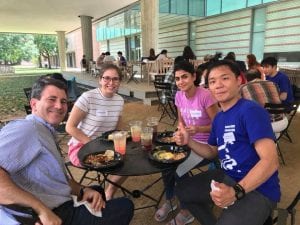
The most helpful seminars this week were the “Introduction to Research in the U.S.” talk given by Prof. Kono and the Welcome Lunch. Prof. Kono kindly told us what we should really do in each week and encouraged us to keep trying everything in the lab. The Welcome Lunch was also important for me to see my mentors, Charlotte and Mahdiyeh, and meet Prof. Natelson (which I didn’t expect) for the first time. We talked each other while eating Tex-Mex food(graph3).
On Aug. 17th, the first Friday of this program, I was looking forward to having fun because I knew the saying “TGIF” (Thank God. It’s Friday.)” and it was the the end of the orientation week. The faculty of Physics & Astronomy held an event, the “Ice Cream Social”, which most of graduate students and professors participated in. I also took part in this event and talked a lot with students and professors while eating ice cream. On Saturday Aug. 18th, some of us went to Brazos Bend State Park with Ogawa-san. It took a lot more time to drive there than we had expected, but we saw a lot of beautiful views in the outskirts of Houston. We found wild alligators and birds there. What’s more, the sunset was extremely awesome when we were having dinner in at a gas station(graph4). After that, we went to the observatory to see Mars and Saturn. It is in Houston that I felt space science is more near to us.
- Fun Fact: Rice University has an observatory too. It is on the roof of Brockman Hall for Physics.
Reflections on Intercultural Experiences
During my first week in the U.S., I have encountered some of both the Core U.S. Values and the Core Japanese Values. As for the Core U.S. Values, I have encountered these in my host lab and a class. In my host lab, nobody spoke to me except my mentors in the first few days. I was a little nervous, but I gave lab members some Japanese snacks and I asked them what they are doing in the lab positively in order to adjust myself to the lab. I think that may be classified “Self-reliance”. During the Laboratory Safety Training, there were a lot of people who have many kinds of background. Instructors gave us such an interactive seminar that some of students spoke up positively. That atmosphere may be classified “Speaking up”. As for the response, I couldn’t do anything about it. I learned speaking up looks like it could be more fun than keeping quiet. Although I am Japanese, I felt comfortable in the situation. On the other hand, when the instructor asked everyone “are there any Japanese hands-up!”, no Japanese students raised their hands. What’s more, in a kind of party ”Ice Cream Social” of Physics & Astronomy, there are many people who talked each other, but I felt a bit shy and wasn’t able to speak comfortably with many new people. These examples may be a reflection of my “Japaneseness”, which tends to be more introverted than U.S. culture.
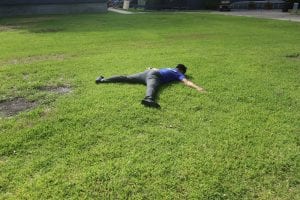
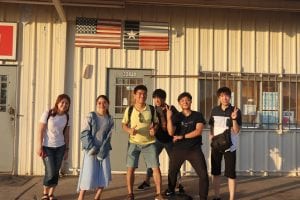
Preparing for Research and First Few Days in the Lab
Prior to my departure, I participated in a poster presentation at an international conference, the 12th Japan-Korea Conference on Ferroelectrics. I was very lucky to get such a rare chance to make poster presentation in English and learn about what an academic conference is like. However, I didn’t have time to carefully review the papers sent to me by Prof. Natelson. Fortunately, there are some common things in terms of nanoscale physics and Raman spectroscopy, but I suggest future students should read and then re-read the papers you are sent and write down some questions you want to ask before leaving Japan.
In first few days in the Natleson Research Group, I mainly observed what other lab members are doing and how they are conducting experiments. My mentor gave me an overview of what she is focusing on and how she makes simulations with COMSOL Multiphysics. In the first lab meeting, I made a presentation about my current research in Japan and shared my weekly plans with lab members. I believe doing presentations like this can make my research project here easier and easier. I suggest that future students should speak up in lab meetings if they have the chance.
Week 02: Life in My Research Lab at Rice
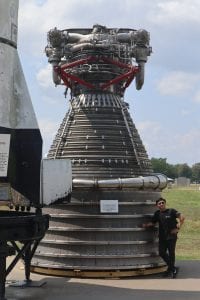
On Monday, I had my initial meeting with all the Natelson Lab members. Prof. Natelson asked all lab members about the progress or problems about the each of their projects in order. As I mentioned in my week one report, I made a presentation about my current research in my home university. Since I belong to the optical team of the Natelson Lab, I had one more meeting on Tuesday in Prof. Natelson’s office. In this meeting, we talked about recent projects more closely and Prof. Natelson explained more about what I am simulating with COMSOL Multiphysics. My mentors, Charlotte and Mahdiyeh, are also members of the optical team. Charlotte mainly gave me an overview of what we are doing now in detail and Mahdiyeh told me how to use COMSOL Multiphysics.
The environment of the lab is so nice and I can easily talk with all lab members. We don’t have any other routines except weekly meetings. I can see messy parts of the lab, but it was seemed to be just like “a lab”. In the lab, I started communicating my greeting everyone positively, so our communication is good so far, but sometimes I couldn’t understand what they said because they speak very quickly. What’s more, I couldn’t speak up instantly due to terminology and unfamiliar expressions in English because I usually come up with what I want to say in Japanese and translate the sentences in my brain consciously. Since my mentors have the patience of a Buddha, they usually answered any questions I have. Everything will be fine, I believe.
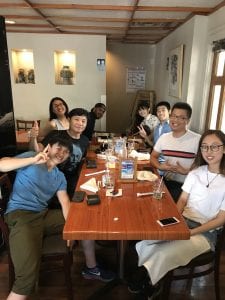
On Aug. 23th, Gen Hayakawa and I played soccer with other Rice students at Intramural Field 6. After that, Shuhei Tsuriya and I went to “JINYA”, a ramen bar in Houston by taking an UBER. Then, on Saturday, I enjoyed visiting NASA Johnson Space Center in Houston. There are real-scale rockets, engines, satellites and so on. That was extremely interesting for me because I had belonged to the rocket club making model rockets in my home university. I’m interested in space engineering even now, so I want to work for it somehow in the future from the perspective of materials science. On Sunday, Gen and I enjoyed playing badminton and eating Japanese food at “NIPPON” with his lab members. Most of them are from China, so we talked about Japanese culture and I ate grilled salmon for the first time after a long time.
Research Project Update
My research project focuses on “The interaction of gold nano structure with different polarized laser in COMSOL simulation”. There are two things to do during this program. One is the COMSOL simulation and another is making new circuit for spectroscopic system for Raman measurement. This week, I actually did a COMSOL simulation with a lot of assistance from Mahdiyeh.
For my research method I am using a simulator, COMSOL Multiphysics so far, but if there is time, I can use a SEM (Scanning Electron Microscope) for our devices, which were fabricated on Si wafers with 2μm thermally grown oxide. Au/Ti contact pads and a common ground (50nm Au with 5nm Ti adhesion layer) were deposited via shadow mask evaporation. Now I’m training to utilize COMSOL. I think this will be useful to save time in near future.
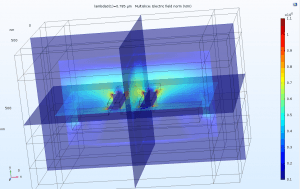
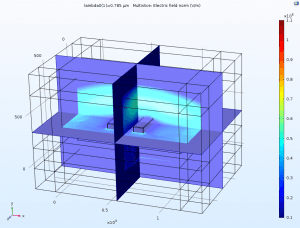
Week 03: Interview with a U.S. Student and Researcher
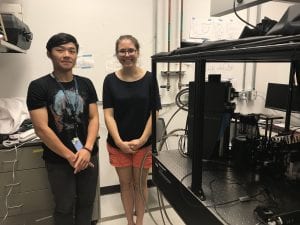
I had two interviews with Charlotte I. Evans who is a Ph.D. student and one of my mentors and Dr. Tim Noe, a Research Scientist in the Kono lab. I was surprised to learn about their enthusiasm for science. I think they have already been independent because they have a definite motivation. Here, I want to share what made them want to become Ph. D. students or researchers and their advice for undergraduate students like us.
The first person I interviewed was Charlotte Evans, who is a 6th year Ph.D. student in the Natelson Lab. She was born in Wisconsin and transferred several times after graduating from high school. Her first major was political science at Ripon College, but she later changed after she took a physics class as she realized she wanted to be an engineer in the future. Then, the professor told her to just study physics because Ripon University did not offer engineering. This college only had only 2 physics professors and 5 physics students so she transferred Marquette University, which had a bigger physics program, more equipment, and students, but she felt uncomfortable there in the big city. So, she transferred again to the University of Wisconsin, River Falls, which also had also a big physics program with lots of students and equipment but in a smaller city. After getting her bachelor’s degree in physics, she came to Rice University because she wanted to do research on fabrication of samples, programming, experiments so the Natelson Lab was a good fit and she felt that Prof. Natelson cares about his students. She mentioned that whether you get Ph. D. or not, “If you want to be able to be a manager with interests in in a lot of different projects, a Ph.D. is a good option.” Finally, she gave me some wonderful advice: “I don’t want you to think that there are any doors closed for you.”
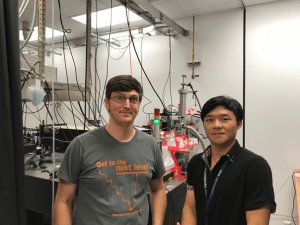
Another person I interviewed was Dr. Tim Noe, who received his M.S. and Ph.D. degrees in Applied Physics under the supervision of Prof. Junichiro Kono from the Department of Electrical and Computer Engineering at Rice University. During his childhood, he was interested not only in physics but also astronomy, dinosaurs, the history and the origin of mankind etc…
He graduated from the University of Southern California with a bachelor‘s degree in mathematics. Later, after graduating from Sam Houston State University with a second bachelor‘s degree in physics, he enrolled in Rice University as a Ph.D. student with an interest in optics related research. After getting a Ph.D., he stayed at Rice University to work as a Research Scientist, after completing a postdoctoral researcher position because it was just fun to establish unique equipment, methods and research there. In doing research, the most interesting moment is the time when he measures completely new data that nobody has measured before. Finally, he gave us great advice too. “Whatever you want to do, just go at it hard. Don’t worry about where you will end up too much.”
In both interviews, I was so excited to listen to them that I forgot about the time, honestly. I think most U.S. researchers and students like them at Rice University have such great motivations that this makes the idea of graduate school in the U.S. so cool for me. I wish I could to be one of them in the future.
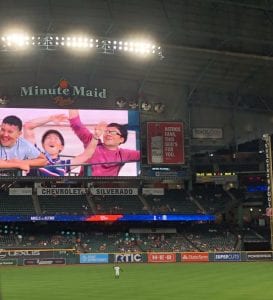
Other Activities in Houston
This week, I can’t help feeling that transportation is extremely significant for playing hard. In fact, I had a lot of interesting events in this week! I want to share my awesome trips in the U.S. and what kinds of transportation I used.
- On Thursday, Aug. 30th, Astros vs. Angels Baseball Game: This was the first I attended baseball game in a stadium in my life! The stadium was filled with an enthusiastic atmosphere that I’ve never seen. Fortunately, we got to watch Shohei Ohtani, a famous Japanese baseball player for Anaheim Angels. What’s more, Gen Hayakawa and I were on the big screen! For transportation used the Houston METRORail, which was cheap and convenient for going downtown Houston.
- On Friday, Aug. 31st, Miller Outdoor Theater in Hermann Park and Rice Village: After running with Prof. Kono and members of “Rice Road Runners”, I went to Miller Outdoor Theater in Hermann Park with Gen and his friends. There was an enormous crowd there to watch the traditional
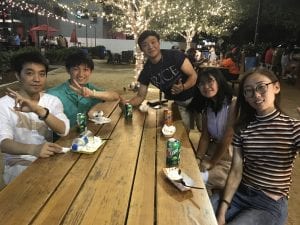
Eating outside at Rice Village ~ Katsuya Shiratori “drum” for their free performance that evening! After that, one of his friends took us to the Rice Village with her car. I heard learning how to drive a car is inevitable if you want to live in Houston.
- On Sunday, Sep. 2nd, One-day Trip in San Antonio: During the long three-day weekend for Labor Day we went gto San Antonio. Gen and I got round-trip tickets on Greyhound, which is a long-distance bus company. I think using these buses is one of smart choices we made. At any rate, we reached San Antonio safely and went to The Alamo, The Briscoe Western Art Museum, The River Walk, Tower of The Americas, San Fernando Cathedral on our schedule. “SWell Cycle”, which is one of rental bicycles, enabled us to visit such a lot of places.
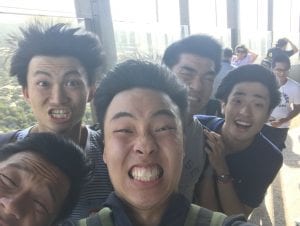
Research Project Update
Let me get straight to the point. My work in my research lab has not been bad at all. At the beginning of this week, I and Mahdiyeh reported the progress of the simulation about my project in the lab meetings and got some feedback about it.
Now, I am re-doing the simulation, but I have had a little difficulty to apply gaussian beam, not plane wave, for the sample without her assistance. On Wednesday, I made presentation about my project and talked about the lifestyle in the U.S. during a one-on-one meeting with Prof. Kono. It made me put my project in order and make sure I could talk about the “Big Picture” of my project. My project focuses on “Plasmonics”, which is the study and application of Plasmons. Plasmons means the quantum of Plasma oscillations. We can see the role of plasmons in stained grass. The phenomenon is attributed to the light absorption of coupling between Plasmons and electric field of the incident on the surface of metal nano-scale structure.
At the end of this week, I tackled a new circuit project for my mentor’s spectroscopic system, which was complicated for me because I had never made a successful circuit. Anyway, I wondered whether making a circuit is research or not, but I didn’t ask it and it made me a stressed as my circuit wasn’t successful this time too. That was a kind of setback. I will have to deal with it somehow next week by discussing more closely with her.
Week 04: Reflections on English Language & Life in the U.S.
I haven’t been as satisfied with my command of speaking English as I would like. I often have to first translate what I want to say in Japanese into in English, but it is seems this leaves me almost no time to spend actually process the real English conversation. Actually, I’ve had the experience that some conversations couldn’t be completed because I couldn’t response correctly in good timing and also make eye contact with the speaker because I was thinking. I should have asked them to stop, and repeat what they said even if I was worried this might make them a little uncomfortable.
What’s more, I found that my English extremely depends on the situation. I was especially conscious about my English skills when some was paying close attention to me, especially if they were Japanese too, because I was too worried about whether my English was correct or not. Finally, I was so afraid of making mistakes that I might try to just get away with the situation by pretending to know or nodding firmly. If I could go back in time I would like to tell myself to “Throw away your pride at any rate, keep following what you can’t understand relentlessly.”
However, it was difficult for me to follow these mental tips completely even if I already knew them. Here, I want to share some practical techniques to improve my language skills and my language learning goal. One is looking into unknown words/phrases in Japanese-English dictionary and writing down your original “vocabulary note” as soon as possible when seeing them. According to the seminar about “Strategies for Vocabulary Acquisition” by Kyung-Hae Bae, Associate Director, CWOVC, language usually has some nuances behind it, so we should pay attention about theses nuances in terms of connotation and collocation.
Another is talking and asking a lot of questions in English. Fortunately, almost everyone in the U.S. is an English speaker, in other words English learners like me can practice listening to and speaking in English anywhere, anytime in the U.S. Of course, English is not our mother tongue, so I believe we have the right to ask about their English positively. I don’t think they would care so much or be annoyed by our asking questions.
As is often case not only with me but also with other English learners, our language learning goal is to omit the process to be translated English back int our mother tongue (Japanese) in our own brain. Rather, we would love to be able to interpret only in English automatically. I haven’t reached such an awesome stage yet, honestly. I’ll keep studying hard!
Other Activities in Houston
This week, I was occupied with a lot of things to do including the interview for U.S. researchers, the poster draft, taking the TOEFL iBT in the U.S. and so on, but I want to share one of my favorite things, what we eat during our daily life at Rice University.
First of all, I often asked mentors or other lab members to take me to the cafeteria of their residential colleges or their favorite place to go to have lunch. In almost all cases, I went to the buffet-type cafeteria in some colleges or “Sammy’s”, a kind of fast food restaurant in Student Center. The former was pretty good because I could eat a lot and drink many kinds of juices and coffee. Although it costs 8$, my mentors treated me, fortunately. Sammy’s was also good. I usually only ate hamburgers here and I can select toppings by writing the order sheet, of course, drink many kinds of juices. I haven’t tried the other menu items because I got addicted to the hamburgers here.
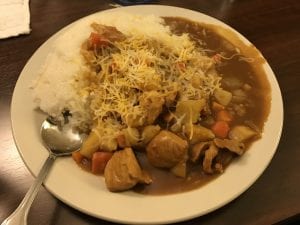
Second, I brought “Rice balls” (onigiri), to the lab as I said this was one of my goals for the summer. Yes, you can have many chances to cook at the hotel by yourself! It is not too much to say that you should cook by yourself if you want to survive here. That is attributed to “the ambivalent food culture” : that most foods in the U.S. are very delicious, but super high-calorie. I think you should try these foods, but you have to burn off these calories in the well-equipped gym at Rice in order to keep good health and not gain too much weight. I learned this from my super mentor, Charlotte. She cooks by herself and gave me her some healthier food ideas than juste eating a hamburger. Thank you very much.
Third, the Nakatani JP Fellow are staying in a three-person room at the Wyndham Medical Center Hotel, which has a nice kitchen. Yes, we can cook all together! I want to say “if you want meals cheaper and easier, work together”. We often take the hotel shuttle bus to the nearest grocery store, “Randall’s” and buy some groceries and then call the shuttle bus or ask the driver to get back and pick us up; usually in 10 – 15 minutes. Fortunately, some of the other male JP Fellows (not me) are good at cooking curry rice. Having them at the take charge of the kitchen, we cooked and ate curry rice.
Research Project Update
First of all, I gave up the new circuit project because it was extremely complicated for me. I learned that even a physics student needs to study how to make a circuit by yourself and how it actually works. Instead of that, I focused on the simulation and spent a lot of time to make the poster draft. At any rate, I have finished making the poster draft which I was able to make by using the data I had in hand and I thought that it was a huge load off my mind. But the draft poster did have some mistakes that my mentors and friends found. I will have to fix them by the deadline to submit the final poster.
The simulation hasn’t completed yet because I haven’t applied gaussian beam for the sample in COMSOL simulation, so I will keep trying to do that until the deadline of the final version of poster. Anyway, what I want to say in my project at Natelson Lab is that the gold nano-structure has the excitation of Surface Plasmon Polariton (SPP) in different laser polarization in terms of both the experiment and the simulation.
Week 05: Last Week at Rice and Research in the U.S. vs. Research in Japan
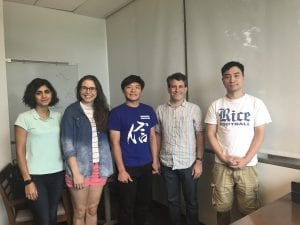
Here, I want to share what my host lab was like and what I thought and felt during the research. For example, the differences between my experiences and expectations, the overall culture of my host lab, and the impact on this experience for my career.
First, I expected that I would be given the opportunity to do more activities in my free time before coming to Rice. However, I had always knew that research would take commitment and a lot of the time to understand what my mentors said and thought in Natelson lab. I asked them (or Google-sensei sometimes) more questions and read more papers about my research topic. I felt that the research process was much harder than I had expected. It was definitely the a continual succession of solving problems.
I think this originates from the overall culture in my host lab. All lab members are responsible for their own research projects, so they try to think and solve every problem first on their own. When they are confronted with difficult problems, they discuss these with each other during the lab meeting around the table and using the whiteboard. Lab meetings are held twice a week, once for the entire group and a second sub-group meeting for just the optics team. I think this gives a good balance between independence and dependence on each other for the progress of our research. I also noticed that lab members typically go home before getting dark and don’t come to the lab on weekend; unless their project requires extended work hours. This is a good lesson for Japan because of the recent promotion of work style reforms.
These experiences in my host lab impacted me in terms of not only practical things but also my future career and/or academic goals. Before coming to Rice, I wasn’t fascinated by a Ph. D. degree because, in Japan, just a Master’s degree is enough for job hunting. However, a Ph. D. is strong and remarkable in the U.S. because I heard that Ph.D. students can define what they don’t understand and implement the next actions based on their original thinking in order to accomplish their goals. I interpreted this as a highly transferable skill. I think that this skill is inevitable to invent something new and novel in the world.
Surely, being able to start your career and earn money earlier is also good, but I don’t want to think that money is the most important thing in my life. I want to think that knowledge is what will make my life affluent. That is why, I have now made up my mind to study abroad in the U.S. especially Rice university in order to get Ph.D. in near future.
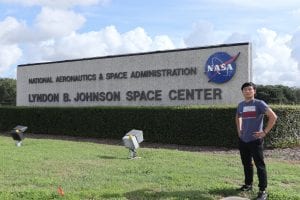
We had Lab visit by Sarah and Ogawa-san the day before our poster presentation. I was very happy to know everyone in optics team gathered Prof. Natelson’s office for this. We chatted and thanked them for hosting me. I felt that I was extremely supported by everyone in the lab during my time at Rice University . I like this photo very much of me and the lab members. This week, we had a fulfilling time in Houston and over the weekend in Philadelphia. We finished studying at Rice University on Friday and traveled to Philadelphia.
Other Activities in Houston
I had decided to go to Johnson Space Center in last weekend of Houston again because I really liked it there and I wanted to watch the exhibitions that I didn’t have time to see the first time. I took part in a tour of the mission control center and watched all the other exhibitions in every nook and corner. I was satisfied with this visit. As I thought, I definitely want to do research or a job related to space.
Research Project Overview and Poster
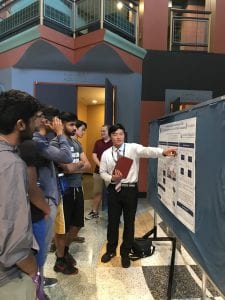
On Friday, September 14th we had our final research poster presentation. Fortunately, I combined my simulation results and previous results earlier than I had expected, so I already knew what I wanted to say in the poster presentation before the final week. In spite of this, it took a lot of time to arrange my poster it in proper way so that everyone could understand it. That was because it was still difficult for me to explain the terminology simply in a short time. I often got confused because I might have misunderstood the physical phenomenon. However, my super mentors helped me and corrected my poster and my presentation again and again. Of course, I practiced harder and harder to be able to rise to their expectations. Finally, my presentation got much better. This is how, I finished up my research project. I learned the criteria for how well my research project finishes should be whether I can explain it to mentors or not.
On the day of poster presentation, we were all very nervous that morning. When the presentation started, I was busy to talking about my project in more details. Before I even noticed it, an hour and a half had gone by and the presentation ended. I really enjoyed talking with the audience about my project a lot.
After finishing the poster presentation, Charlotte took me to Rice Village and we had a great time to eating delicious tacos and ice cream. When she gave me a ride to the hotel, I said “Now, I want to continue to do this research with great interest in the future because it has some future steps that I couldn’t complete during this program”.
Research Project Poster (PDF): “The interaction of gold nanostructure with different laser polarization in COMSOL simulation”
Host Lab at Rice University: Natelson Research Group
Host Professor: Prof. Doug Natelson, Depts. of Physics & Astronomy (Chair), Electrical & Computer Engineering, and Materials Science & NanoEngineering
Mentors: Mahdiyeh Abbasi, Charlotte I. Evans
My research theme is “The interaction of gold nanostructure with different laser polarization in COMSOL simulation”. I conducted this research at Natelson Lab with Prof. Douglas Natelson, Mahdiyeh Abbasi, Charlotte I. Evans.
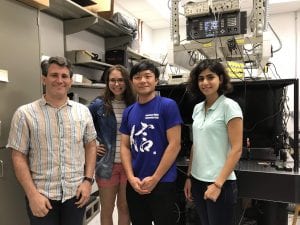
We are studying about Plasmons, which is a collective oscillation of conduction electron in a metal like a gold and Surface Plasmon Resonance (SPR), which is the resonant coupling between the incident laser and the conduction electrons. Especially, in nanoparticle and nanostructure the most common type people use, Localized Surface Plasmon Resonance (LSPR). It can cause large enhancement of electric field and a lot of heat from this. It can be used for better sensors and Surface-enhanced Raman Spectroscopy (SERS) with single molecule sensitivity.
We have measured some devices and got interesting results seeing different type of plasmon, which is called Surface Plasmon Polariton or SPP. We wanted to know how we can simulate this in COMSOL and whether or not actually we detected this by using photothermoelectric effect.
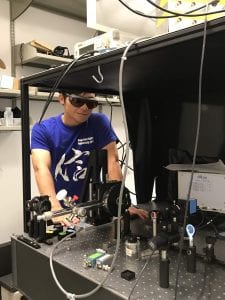
In our previous results, we use lock-in measurement in order to create photothermoelectric (PTE) map. No matter how the polarization direction is, we got same results in nanowire. However, we saw the features highlighted topological differences in the gold pad. PTE map in the polarization direction along x-axis was more remarkable than the other polarization direction. I used COMSOL, which is one of simulators and can deal with a lot of physical phenomenon at once. I made simpler simple 3D devices with smooth edges which can save much time in simulation and made Perfectly Matched Layer (PML) and Mesh, finally, I applied plane wave on it. Thanks to PML, we can stop electromagnetic wave reflecting more than twice. Thanks to Mesh, computer can recognize the sample in simulation.
We got simulation results about total field and energy absorption around the steps with different laser polarization. Total field and energy absorption in the polarization direction along x-axis are more remarkable than the other polarization direction. As a conclusion, our simulation results are consistent with previous experimental results because energy absorption is strongly related with open-circuit voltage. We could surely detect SPP in experimental devices.
As a future perspective, we will apply gaussian beam, not plane wave on this sample in order to get more accurate results.
Week 06: Last Week in the U.S.
After the poster presentation, we moved to Philadelphia, Lehigh University, and Washington D.C. for our final week in the U.S.. We had a super fun time there. Here I want to share about my experiences at Lehigh University and in Washington D.C.
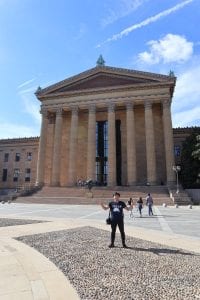
After finishing the poster presentation, my tension was released and I was able to focus more on what would make the rest of this stay great. On Saturday, we flew to Philadelphia and on Sunday we had time for sight-seeing. We went to the Independence Hall and took a double-decker bus to Eastern State Penitentiary, which was a historical prison managed by the state. After that, we walked to the Philadelphia Museum of Art. I hope to be able to understand the art more in the future.
During our visit to Lehigh University, the weather was not very good and we had to get up early in the morning for seminars. However, I was astonished to see the buildings at Lehigh University because they were so historical and sophisticated and appeared through the fog. Having looked around the campus, I found some unique things. One was that sustainable activities by both university and the students are very active. For example, there are “Smart Bins”, which press the trash automatically and are charged by solar panels. That was interesting because I haven’t ever seen a university installing that system. Second is that students at Lehigh university have not only a major but also minor. I was surprised that this is common in Lehigh University. I wonder why how it works.
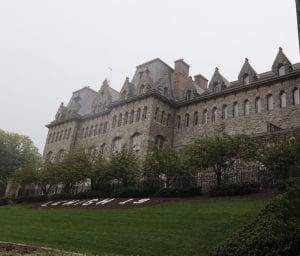
After the program at Lehigh ended, we took a 3-4 hour bus ride from Lehigh University to Washington D.C. and went walking around the hotel in Navy Yard that evening. We saw the sunset and a beautiful landscape of the city for a moment. Then, looking back at this stay, I thought that what an awesome program we are participating because we had been to four states (Texas, Pennsylvania, Washington D.C., and Virginia) in the U.S. at once. Anyway, this was the beginning of our trip in Washington D.C., the capital of the U.S.
In Washington D.C., we visited a lot of important places in the U.S. in terms of politics. For example, we saw the White House, Pentagon and other government agencies. You can see them frequently while just sightseeing. What’s more, we visited remarkable memorials like the Jefferson and Lincoln Memorial. These were breathtaking because of how large and solemn they were.
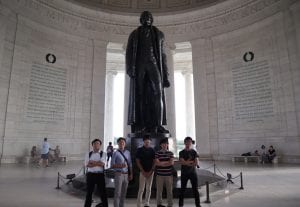
We had not only had time for sightseeing in Washington D.C., but also participated in seminars related to our future careers as a researcher. We visited JSPS (Japan Society for Promotion of Science) and the NSF (National Science Foundation). We learned about the system of research funding in academic fields in Japan and the U.S. Although I believe money isn’t the most important thing, I now better understand the importance of funding and how this can impact the research.
Finally, I want to briefly describe my feelings on the plane at the end of this program. Honestly, I don’t want to back to Japan. Surely, I felt I grew rapidly in through the challenging situations I faced during this short term program, but I’m not yet satisfied with this growth. That’s because my next stage is coming soon. In order to going to this, I will be required gain even more high-level English skills and research skills in the future. All I can do is to keep try hard to make a good effort with these goals. I plan to do this even after I return to Japan.
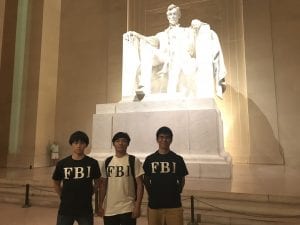
Question of the Week
How does the system of majoring and minoring work in the U.S. for undergraduates?
- In the U.S. higher education system, undergraduate students apply to and are admitted to a university. When they start their freshman year, they do not yet have a major or department that they are member of. Instead, they will take a range of ‘liberal studies’ classes and classes in fields/topics they are interested in and then in the sophomore (B2) year typically will ‘declare’ which major they want to pursue. The university does not assign you to a specific field of study based on your entrance exam scores, instead it is ‘up to you’ to choose which major/s you think would be the best fit for your interests and long-term goals.
- It is very common for undergraduate students at all universities in the U.S. to pursue a major and a minor. At Rice University it is even more common for undergraduate students to pursue two majors (double major) or even get three majors! Click here for a full list of all undergraduate majors, minors, and certificates at Rice. Other universities in the U.S. would have a similar list that you could find on their websites.
- However, graduate students at the Master’s and Ph.D. level typically apply to and are admitted into a specific program of study (e.g. Ph.D. program in Electrical & Computer Engineering). So, they must apply to the specific department for the graduate program they want to pursue. It is difficult to change your degree program at the graduate level, though there may be different research tracks or concentrations/focuses that you can pursue within that degree based on your research interests.
- There are joint Ph.D. and professional degree programs such as the joint M.D./Ph.D. program between Baylor College of Medicine and Rice University or the joint MBA and Master’s of Engineering program at Rice University with the Jones Graduate School of Business. It is much less common for graduate students to pursue dual or joint degree programs as it can take a long time to finish the requirements for both graduate degrees.
Final Report
Now that I have been back in Japan for about a month, I would like to reflect and write my experience and thoughts about the U.S. overall in order to share with Nakatani Foundation, future applicants, my family, and so on. Especially, I will give a potential students some advice and tips at the end.
First of all, I want to say that the most important thing I learned from this program is that research in the U.S. will make you great. There are two reasons for this: Ph. D. life in the U.S. and being in a multicultural field. To begin, I summarize distinctive features of Ph. D. life in the U.S. below.
- Ph.D. in the U.S. is a performance-based system where you are placed under some pressure and people are responsible for showing results in their research.
- Most Ph.D. students are “employed” as a kind of researcher by their professors instead of paying tuition. (I’d like to tell my parents “Don’t worry too much about money, all is well.”)
I think this system is the reason why the U.S. is a leading country all over the world. At the same time, everyone, including me, thinks Ph. D. life looks very hard. Although this is definitely true, I just wondered why people who got Ph.D. degree made it. The answer I found through this program is passion. Most of the people I met during this program are passionate about their own research or projects. They look like they are having more fun than any other people. What you are passionate about makes you great, I believe.
Second, universities in the U.S. have many students with different backgrounds. While this may be well-known, the good points are controversial. I think one of them is that I can now more profoundly understand where I am from. For example, when I left Shizuoka, my hometown, I was able to notice its features. If I hadn’t left Shizuoka, I couldn’t have understood about my hometown. That is how, by going outside our comfort zone we can learn about our origins objectively. This is also the reason why an international experience is important.
Consequently, this program helped us understand what a Ph.D. in the U.S. is, why it is worth to getting, and our next steps. I think all future students should just do your best. Although I believe I did my best in this program, I’m not satisfied with just this experience. All I have to do is to make efforts in order to realize my ideal plan: going forward I hope to study at Rice as a graduate student, hopefully. I sincerely appreciate all the people related to this program.
Tips for Future Participants
- Working in a Research Group in the U.S.: Read as many papers as possible and asking lab members lots of questions.
- Studying/Speaking in English:
- Don’t panic and be overwhelmed! If you can’t understand what they said, you should ask again, and again. Just try it!
- There is a dilemma about studying language. When you are with other Japanese Fellows, you will speak Japanese. That is very fun, but you want to study and speak in English. You should have an adequate balance between speaking English and Japanese.
- Packing Tips: Pay attention about the weight of luggage. A scale is very useful.
- Things to do at Rice University or in Houston: You should go to Rice Village and the Museum District.
